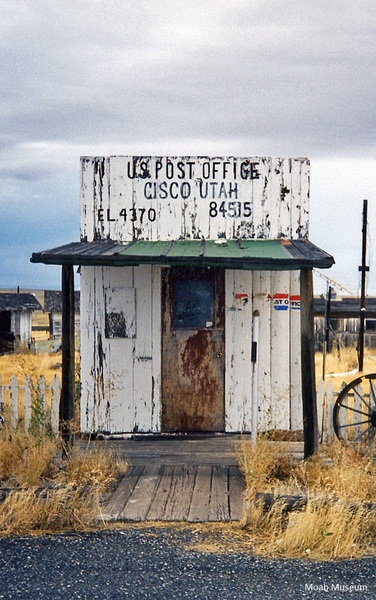Dublin Core
Title
Description
On the eastern edge of Grand County, a few miles south of Interstate 70, sits the tiny ghost town of Cisco. Founded in the 1880s, Cisco was once a bustling western town with boarding houses, stores, and plenty of saloons. The town served as an important transportation hub into the mid-twentieth century, but its economy ebbed and flowed as industry and consumer demand changed.
Cisco played a critical role for the Denver and Rio Grande Railroad, which extended through northern Grand County in the 1870s. Water pumped from the Colorado River to Cisco was used to resupply locomotives, which required steam to operate. In turn, the railroad was a lifeline to settlers of the region, allowing people in remote towns like Dewey, Castleton, and Miner’s Basin to access imported goods.
Other industries also found advantage in Cisco’s location. The town became a hub for local cattle and sheep operators looking to export livestock, and seasonal sheep-shearing outfits and cattle drives brought an influx of workers throughout the year. However, it wasn’t just agricultural opportunities that flourished. Geologists also discovered oil and gas in the rocks beneath the area around Cisco and intermittently pursued extraction, making petroleum a possible industry for the town.
As cars became increasingly accessible, Cisco became an important transportation hub once again: this time for gasoline available on a remote stretch of lonely road. Routes US-6 and US-50 both passed through the town, and thanks to its remote location, Cisco was an essential refueling stopover. Local gas station operator Mary Cowger Hepperle recalled that during the 1940s, “Travelers who stopped for gasoline often would ask how we could stand to live so far away from anyone. I told them that we saw more people in a day than most city dwellers."
Cisco’s industries continued to adapt as the rural landscape changed. When Interstate 70 was completed in 1970, its route bypassed Cisco and the town’s population dried up. In recent years, an artist residency and a general store have emerged. In fact, the 2020 US Census listed four people, up from zero in years prior, beginning a new chapter of the ghost town’s story.
Creator
Source
_______________
See Daughters of the Utah Pioneers,Grand Memories, Utah Printing Company, 1972; Richard Firmage, A History of Grand County, Utah State Historical Society, 1996; Mary Cowger Hepperle, “Memories of Cisco,” Canyon Legacy (no. 51), Summer 2004.

